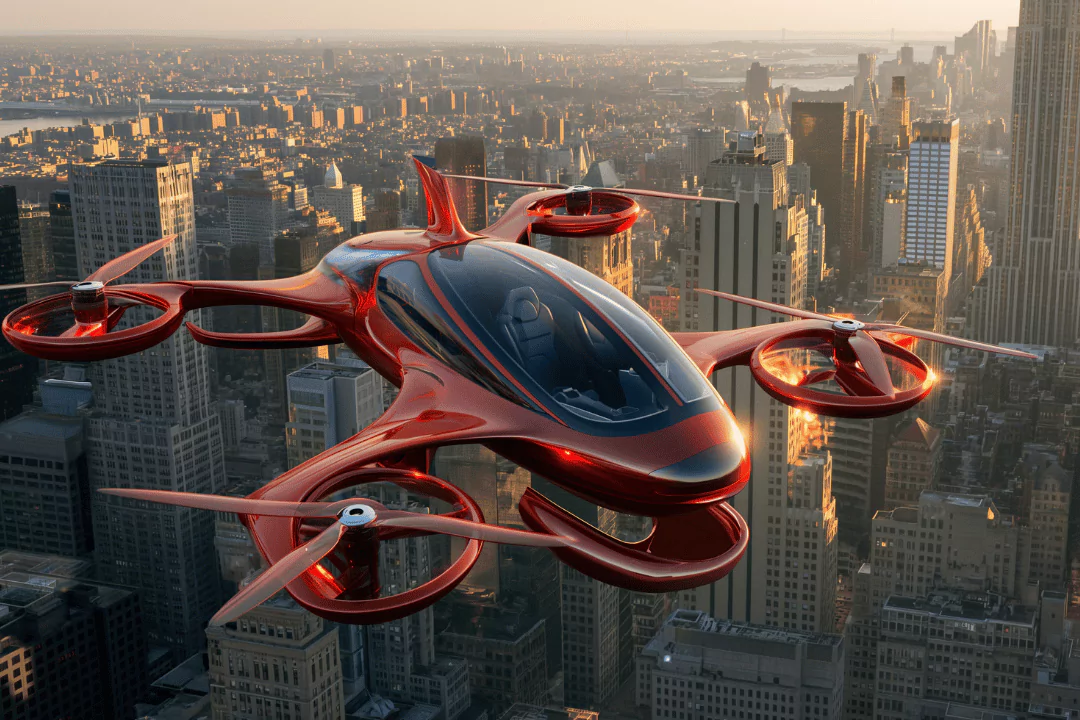At a Glance
- Urban Air Mobility (UAM) promises to transform urban transportation with air taxis and aerial vehicles, aiming to “revolutionize how we navigate congested cities.
- Significant challenges include meeting “stringent safety standards,” overcoming regulatory barriers and integrating advanced air traffic management systems.
- UAM offers the potential to “dramatically reduce commute times” and ease urban congestion, but success hinges on collaboration across industries and government agencies.
Navigate the complex landscape of Urban Air Mobility (UAM) as it promises to revolutionise transportation by 2030, addressing challenges from regulatory hurdles and operational complexities. Explore the critical role of AI and big data analytics in realising the future of UAM to reshape transportation, making intra-city air travel more accessible and efficient.
Sky's the Limit: The Future of Urban Air Mobility
According to NASA (National Aeronautics and Space Administration), the aerospace industry will handle 130 million passenger trips annually by 2030. This growing demand has significantly increased research and development investments for eVTOL (electric Vertical Take-Off and Landing) technology from $2 billion to $30 billion over the next decade. Major companies like Boeing with their Passenger Air Vehicle and Airbus with the A3 Vahana are leading the way, while many emerging companies are using their innovative edge to revolutionise urban air mobility.

The role of artificial intelligence in the success of eVTOL and flying cars cannot be overstated. AI is the driving force behind precise navigation, efficient operation, energy management, and enhanced safety, making the vision of urban air mobility a possibility and an imminent reality. This technological advancement underscores the industry’s commitment to safer and more efficient transportation, paving the way for a future where urban air mobility is a part of our everyday lives.
Key Challenges in Urban Air Mobility
Urban Air Mobility (UAM) promises a future where flying cars seamlessly integrate into our daily lives, revolutionising passenger transportation, logistics, and more. This vision is a beacon of innovation and progress for the aviation industry and technology developers; however, it faces some initial challenges.
- Technology Maturity: Adequate energy storage is essential for extended endurance and the rapid application of thrust for vertical take-off. It is also crucial to effectively integrate AI/ML computing, autonomous navigation systems, and surveillance systems for detecting and avoiding obstacles and ensuring all-weather operations.
- Infrastructure: UAM requires significant infrastructure investment. This includes building Vertiports (vertical ports) on top of skyscrapers and skyports at various city locations, smart local grids for rapid charging and load balancing, ground-based command and control systems for fleet management, and secure communication.
- Advanced Sensor and System Integration: For seamless UAM operation, it is essential to integrate advanced sensors and systems into both airborne and on-ground computing systems. This requires the use of big data analytics and AI/ML to facilitate prediction and conflict resolution. Integrating data from various sources into a dashboard, including weather, traffic, and ground control, is crucial for making real-time decisions and ensuring safe and efficient operations.
- Regulatory Hurdles: The Code of Federal Regulations has significantly amended performance-based standards for small airplanes, indicating the drive for innovation to shape requirements for UAM in the coming years. European Union urges a framework to engage non-aviation stakeholders such as city administrators, National Airspace agencies, and other aviation stakeholders. The emerging framework is maturing and on its way to global adaptation. Recently, the FAA lifted the beyond visual line of sight (BVLOS) constraint, a breakthrough that could pave the way for technology advancements such as eVTOL and further enhance urban air mobility. These developments instil confidence in the future of UAM.
- Operational Complexity: Navigating through complex airspace over a city landscape filled with structures, power, and communication lines, tracking and avoiding obstacles, addressing navigation errors caused by GPS-denied situations or line of sight issues, resolving conflicts in air traffic as urban air mobility (UAM) becomes more prevalent, and establishing necessary technology aid to overcome the operational overhead.
- Social Acceptance: Addressing privacy concerns, minimising noise pollution, and building confidence among the public to embrace new technologies are crucial for the widespread acceptance of UAM. Availability, accessibility, and affordability are key for rapid social acceptance.
Overcoming these challenges will be key to realising the full potential of UAM, unlocking new possibilities for transportation and urban development.
AI: The Architect of Urban Air Mobility's Future

Artificial Intelligence (AI) plays a crucial role in enabling Urban Air Mobility (UAM) by providing transformative capabilities across different areas. Traditional AI applications, like predictive maintenance, help in effective inventory management to reduce downtime and improve operational efficiency. Additionally, AI and machine learning (ML) further advance UAM operations through:
- Enhancing the situational awareness of flying cars and Urban Air Mobility (UAM) vehicles involves processing large amounts of data from onboard sensors and various ground-based systems, including surveillance and weather radar. This process empowers localised decision-making, providing real-time insights into the operational environment and enabling dynamic operation based on environmental conditions, ultimately enhancing operational safety and efficiency.
- Predictive maintenance by analysing the volumes of data sourced from different sensors and flagging deviations between data originating from the redundant channel for any performance degradation or anomaly. This improves UAM reliability, availability, maintainability, and safety. It reduces downtime and operational costs for operators.
- An AI algorithm equipped with access to air traffic, weather, passenger behavioural patterns, and real-time situational awareness can plan an optimised flight path for fuel efficiency by simulating thousands of scenarios.
- AI/ML algorithms improve autonomous flight capabilities and reduce the workload for single-pilot-operated UAM while maintaining flight safety.
As the industry prepares for UAM, AI emerges as a key enabler, driving innovation and efficiency while ensuring safety and passenger comfort.
Navigating the Urban Jungle with Big Data Analytics
In Urban Air Mobility (UAM), various solutions are being investigated to find alternative navigation aids. Maintaining a continuous GPS signal in a city filled with skyscrapers is challenging, especially when manoeuvring UAM, as it can deter the line of sight. Additionally, GPS signals are vulnerable to jamming and spoofing. Adding Anti-jamming devices could make UAM costs like those of any commercial jets. Technologies such as magnetic velocity, and positioning, celestial based navigation aids are being explored to address these challenges, but they are still in the early stages of development.
Alternatively, equipping more sensors such as high-definition cameras, RADAR, and LiDAR can help building a perception around the aircraft level, enabling better situation awareness. Big data analytics processes this wealth of sensor data, providing insights into navigation, communication, and operational challenges, ultimately paving the way for safer and more efficient urban air transportation systems.
Cloud-based navigation, a cutting-edge solution, enhances UAM navigation by pushing all data into the cloud. Here, navigation systems can process it to provide precise guidance. This cloud-based navigation also taps into other data sources like traffic and weather, which, when used with big data analytics, can further enhance accuracy. The advancements in communication speed, reliability, and availability make this cloud architecture a robust and efficient solution, reassuring the reliability and efficiency of UAM navigation.
A Transformative Journey Ahead
Like the commercial aviation industry, UAM needs clear regulations already in place with international civil aviation authorities. Local bodies should form a committee to develop pricing strategy for trips, energy grids, infrastructure, and the integration of aviation with non-aviation elements while creating a legal framework.

The next few years will witness the maturity of urban air mobility (UAM) technology, safety regulations, and well-defined operational performance standards, setting the stage for broader acceptance. Over the following decade, passenger acceptance will become evident as service providers increasingly incorporate UAM trips into their offerings.
In the next decade, we can envision a mature UAM landscape, with a select few leading players offering UAM as a comprehensive service. This transformation will be propelled by the escalating demand for efficient transportation solutions in sprawling metropolises. UAM, with its ability to provide a dependable transportation system that can complement existing rapid transportation systems, will be a game-changer. Cities like Mumbai, Tokyo, London, New York, and Los Angeles, grappling with their transportation woes, are likely to be at the forefront of this revolution.
UAM’s impact will not be limited to passenger transportation. It will also revolutionise logistics for eCommerce, medical, and other essential services. The technology’s maturity in these sectors will accelerate the UAM journey, making it more accessible to a wider demographic.
This democratisation of air travel will reshape the industry in ways we can’t yet fathom. Original Equipment Manufacturers (OEMs) and suppliers can seize this opportunity by investing in technology startups and aligning their financial strategies to support the growth of UAM.
Author
Jayaraj Rajapandian
Head of Avionics, Tata Elxsi
Jayaraj Pandian is the Head of Avionics at Tata Elxsi, with over 25 years of experience in engineering and technology. He has a strong background in Aerospace product design, development and certification. Jayaraj has led engineering teams across India, USA, China, Czech Republic, and Mexico, driving strategies that have resulted in significant new product revenue growth. His product development expertise and strategic planning skills have developed and led engineering teams successfully in Aerospace.
Karthik SP
Senior Group Manager, Emerson T & M (NI)
Karthik SP is a Senior Group Manager at NI (now part of Emerson) with over 17 years of experience in the Aerospace & Defense industry. He leads technical teams in the JKAI region, focusing on customer success, innovation, and system design. With a background at Moog, Honeywell, and AMETEK, Karthik brings extensive expertise in overcoming industry challenges. At NI, he collaborates with technologists and engineers to enhance productivity and drive growth, ensuring NI’s leadership in the Aerospace & Defense sector.

